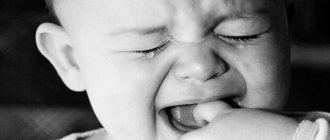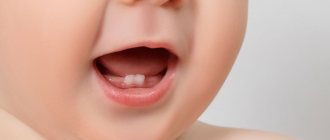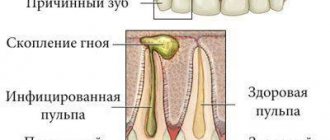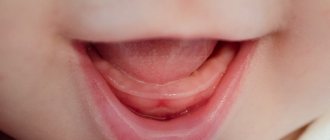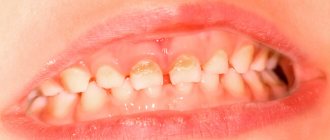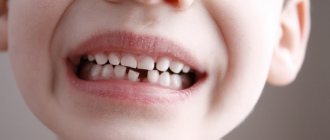Teething in an infant is a very exciting moment in the life of the baby and his parents. And although teething is a physiological process, almost all children experience discomfort and anxiety during this period. From the point of view of a scientific approach to this problem, the difficulty lies in the fact that with all the variety of teething symptoms from mild restlessness and moodiness, increased salivation to an increase in body temperature to high numbers and signs of impaired digestion, increased colic and diarrhea, there are no sufficient diagnostic criteria to connect all these numerous symptoms to the root cause. Nevertheless, many parents and some practicing pediatricians are still ready to blame the baby’s teething for almost all the troubles that befall them in the period from 5 - 6 months to one and a half - two years, when the teething process is mainly teeth should already be completed.
Most children begin teething between the ages of 4 and 7 months. As a rule, the eruption of each tooth lasts from 2 - 3 to 8 days. During this time, it is possible to increase body temperature to 37.4 - 38.0 degrees. At the same time, high temperature (from 38.0 and above) usually lasts no more than 2 days. Nasal discharge during the period when teeth are erupting is usually transparent, liquid, and should not contain pathological impurities: pus, greens, etc. Cough during teething is caused by saliva entering the nasopharynx and larynx area, which is released in large quantities. Cough due to teething does not require treatment. Regarding diarrhea, pediatricians sometimes differ in their opinions: some believe that diarrhea (loose stool) is not directly related to teething. And yet, studies have shown that from 10 to 30% of children have frequent and/or loose stools during teething. This is also explained by the large amount of saliva secreted, which enhances intestinal motility.
Teething or infectious disease
However, most modern pediatricians agree that such symptoms in an infant as: long-term, over 2-3 days diarrhea, cough, vomiting, fever (increase in body temperature above 38.5 degrees) are most often caused by infection, and not just teething teeth. Therefore, with any of the above symptoms, it is necessary to examine the child by a pediatrician, and only after other causes of increased body temperature have been excluded, efforts should be concentrated on helping the baby to reduce the discomfort from teething.
Signs of teething in a baby. How to identify them?
The signs that parents expect—fever and pain—do not appear immediately. But it is still not difficult to recognize that the baby is starting to teethe.
If you notice that your child has begun to salivate excessively, and he tries to taste any thing that is in his hands and chew it thoroughly with his gums, it means that the baby is teething. This sign never fails. During this period, it is especially important to monitor the cleanliness of toys and other hygiene at home.
The second sign of teething is swelling and redness of the gums. In order to detect this, you just need to monitor the baby’s oral cavity, paying attention to the tops of the gums. If you see white spots there, it means it’s time to buy a special device at the pharmacy - a teether.
The third sign is a bad mood that the child experiences from periodic pain. The baby becomes uninterested in playing, he often cries and is capricious, and as a result, his night’s sleep may deteriorate. This period lasts only two days, but parents should be patient and show their love to their child more often than usual.
The fourth, most unpleasant sign of teething is various pains and fever. It is important here not to confuse these pains with cold symptoms or stomach upset. The baby may develop a runny nose, diarrhea, fever, ear pain and a general weakening of the immune system; in addition, the gums may hurt and itch very much. During this period, the child's vulnerability to infections increases. This condition can last two or three days, but it ends as quickly as it appeared.
Teething: how to help your baby
This may require a fair amount of patience. During such a difficult period, you should take the baby in your arms more often, caress him, distract him from unpleasant sensations with toys, turn on pleasant, soothing music, and you can sing if natural abilities allow. A walk in the fresh air can also have a calming effect. Children who are breastfed, during teething, begin to cry more often and ask for the breast, and a loving mother needs to be patient, putting the baby to the breast every time, even if he grabs the nipple areola harder than usual during feeding. To satisfy the child’s need to chew something and hold something in his mouth, you can naturally use special rubber rings or toys, so-called teethers. You can offer your child dry food or baby cookies.
Currently, pharmaceutical companies offer a wide range of different products, primarily in the form of gels to “soothe the gums.” In general, most of these products contain painkillers such as lidocaine. You should not abuse these funds. They are not completely harmless; the anesthetics they contain can have an adverse effect on the child’s nervous and cardiovascular systems, and most importantly, they can cause serious allergic symptoms and contribute to the exacerbation of atopic dermatitis (diathesis) in children prone to allergies. In connection with the above, I can recommend, to reduce swelling and inflammation of the gums during teething, such special dental anti-inflammatory drugs for topical use as Cholisal gel, which can be applied to the baby’s gums 2-3 times a day, but must be rubbed in (not too much). of course) with light massaging movements over the entire surface of the gums, and not just putting it in the child’s mouth.
In addition, you can give a child suffering from teething special homeopathic drops, for example Dantinorm baby, according to the instructions for the drug. In any case, if the disturbing symptoms described above in this article appear, I advise you to play it safe once again and call a pediatrician to the home of a child with a high fever. A professional should give his diagnosis and recommendations.
We talk a lot about how sleep gets worse when teething .
Does teething actually affect sleep?
I am for action, for working no matter what, in spite of everything, slowly but surely.
Teeth are inevitable.
What to do if teething and the baby does not sleep at night? There is a solution!
- Firstly , we alleviate the symptoms, there are a lot of life hacks.
- Secondly , if teeth are starting to creep in at the preparatory stage, we set up a PASSPORT, study the baby’s habits regarding activities and relaxation, fill ourselves with resources, and learn to delegate. Just look, by the time they erupt, the regime has already been set up, and you have a handsome PASSPORT. And they strengthened their attachment, and filled themselves, and then they were just a stone’s throw away from falling asleep (but no one canceled work).
- Thirdly , if, using the method of teaching yourself to fall asleep, suddenly everything in your mouth itches, swells and turns white - the same principle: we work slowly but surely, we relieve the painful sensations according to the advice. We stop at the stage where we were taken by surprise. Or a slow movement forward, maybe one step back, but then two steps forward (I love this rule dearly, it’s so soft, it works in all areas).
☝️ Just let's be honest - first you have colic, then teeth, then regression, then a growth spurt, then you turned on the batteries, went to the dacha, teeth again (three months in a row and no teeth in the end). This is a hidden benefit, resistance . This is anything, just to suffer and not get sleep, being in the state of a victim in the omnipresent Karpman triangle. I come across this in the course “BABY’S SLEEP, MOTHER IN RESOURCE” every day - the work goes on, despite “heredity”, “genes” and a burdened medical history. Work is underway. Dot.
But when you already have teeth, then you need to take care of them.
A short story to support the above. The result of work on the course of one mother, with whom we carried out quite a large amount of work. We received feedback.
The only peculiarity is that with any rollback, the mother allowed the child to roll back to complete zero.
In her review, she wrote: “Nothing has changed, the baby has been sleeping with the breast for the last two days.” Although the routine was set up, the duration of sleep was increased, bedtime was shortened, work on self-sleep began, and we were already halfway there, but the child quickly followed the slow method.
But teeth. Rollback.
Again on the chest. Another week of work and now the child falls asleep while being stroked, the mother sits next to him. ⠀ Moving. We took a break. Rollback again.
I understand this mother - when after the first steps sleep improves and instead of 10 awakenings at night there are only 3, it seems that it has always been like this. But all PASSPORT forms remember the story of mother’s suffering, even if she forgot. And mom relaxes when she can sleep for 3 hours straight. And this is where the danger lies. It’s easy to fall asleep again at your chest, especially if there are teeth, guests, and races. It is more difficult to return to laying without breasts. Sometimes it’s completely unrealistic without additional incentive and support. As a result, in 6 weeks of work, my mother had everything - amazing progress and equally rapid setbacks.
There is a secret ingredient to working with sleep - it is always the MMP (leading maternal position).
Honestly, no matter how advanced the methods are, the leading maternal position is primary, and all methods are secondary.
Author: Tatyana Kremneva.
When do the first teeth appear?
Most often, the first milk chewing organ appears at 4-7 months. Mothers notice symptoms before active growth in advance, from 3 months. The generally accepted timing of the birth of rudiments is arbitrary. Minor deviations from them are normal and should not bother moms and dads. After all, the rudiments of future teeth in newborns are formed long before their appearance, even in the mother’s womb. Many experts believe that the process depends on genetic predisposition. Prevention of caries in children is very important. Although some adults mistakenly believe that temporary rudiments do not need to be treated, as they will fall out.
There should be 20 milk units. The order of their appearance according to the generally accepted scheme is as follows:
- First, the lower first incisors make their way through the gums. They are also called medial.
- Then the upper first incisors appear.
- After them, the upper second incisors grow, and then the lower second incisors, which are called lateral incisors.
- Next, the upper first molars are shown on the surface of the mucous membranes, and then their lower antagonists.
- Only then do the upper and lower fangs grow.
- The lower second molars appear last, followed by their upper antagonists.
The timing and priority may not coincide with the generally accepted schedule. Relatives, of course, should monitor this process, but there is no need to panic. All controversial issues should be resolved with a pediatrician and pediatric dentist. It is important to remain calm and patient so as not to create conditions for a stressful situation that will negatively affect the baby’s health.
When you don't need to improve your child's sleep
29.08.2015
4
Before becoming completely exhausted from endless night awakenings, hours of going to bed and tears every time you wake up, every mother asks the question: “Maybe now is not the right time to work on improving sleep?” And there are always a hundred reasons that confirm the thesis “it’s not time”: he’s still little, vacation is in a couple of weeks, teething, vaccination, the older child is going to first grade, a new baby will be born in a couple of months, the last adventure in the hospital was already traumatic, and many more Total. In practice, you can put off active work for years with the hope that you will soon outgrow it and everything will get better on its own, simply because...
I would like to offer a couple of maxims about why you shouldn’t start now, or vice versa – why now is the time! So, let's deal with the bad points for starting work:
Active malaise
Whether it’s a common ARVI with a runny nose and fever, dermatitis that itches unbearably or otitis media – in a state of acute discomfort, it’s simply not fair to demand that your child learn a difficult new skill. At such a time, we must help, support, do everything (really, EVERYTHING!) that will help the baby feel at least a little better, sleep longer and get better faster. However, here’s the trick - it’s important not to wait endlessly for an ideal state - children recover quickly and often the mother remains the most traumatized creature by this ailment. Remember that a little redness on your back can last for months, a slight runny nose will leak for a couple of weeks, and a bruise from a fall on the stairs will last for a couple of days, and poor sleep will not help them go away.
How to proceed: Get rid of acute conditions such as fever, cough, congestion or uncontrollable itching and get to sleep. A baby who sleeps well gets sick less (sleep seriously supports the immune system) and gets better faster!
“Baby D., (11 months old) got a slight cold right on the second day of working in the program, but because... There was no fever or congestion, my mother and I decided to continue and by the end of the first week the baby pleased everyone with a full 12 hours of sleep per night!”
Teething
Teeth are the number one reason why moms are hesitant to start actively improving their sleep “now.” Let's figure it out: teething is a natural physiological (and therefore normal) process. Yes, it can be painful and even accompanied by fever, diarrhea, rash or vomiting (in this case, see the point above). However, active discomfort during teething rarely lasts more than 2-4 days and certainly does not last for months, as it may seem to a tired mother. When teething, the baby worries around the clock, and not just during sleep periods. Most children benefit at least temporarily from medications approved by pediatricians for such cases.
How to act: We wait out the acute period with fever and other violent manifestations. Sluggish teething is not an obstacle to improving sleep, and most of the remedies available to the mother greatly alleviate the baby’s condition. Remember, children start teething until they are 2+ years old, and this does not mean that no one should get enough sleep all these years.
“Brisk M. (6 months) began to show signs of teething as soon as mom received her plan, (or was it mom’s concern?), but because... We didn’t notice any severe discomfort, my mother decided to act, using the doctor-recommended gel on her gums for temporary relief, and after 10 days everyone in the family was sleeping at the right time, and the first tooth erupted only after 2 months.”
Upcoming trip - vacation - change of location - moving
If there is less than a month left before the trip, then there’s really no point in starting. Especially if, due to your plans, you know for sure that you will not be able to maintain a stable “correct” regime, the baby will not have a separate sleeping place and you will often have to organize daytime naps in a stroller. Changing time zones in itself will not be a huge complicating factor, especially if the clocks move no more than 3 hours in any direction.
How to proceed: Plan your trip in advance - if you have a month, go for it! Also, when planning your trip, keep in mind that you are traveling with a baby who needs a routine and a comfortable sleeping environment.
“Yu’s mother (16 months) decided to act during her vacation, when there were three weeks left before returning home. She was sure that at home she would be able to maintain a routine, and the baby was waiting for his usual apartment, 2 hours away from the place of rest. “He not only did a great job and delighted his mother with super-sleeps from the second day, but also slept great at home in his crib on the very first night after the flight home.”
"Difficult age stage"
It is no secret that in the first couple of years of a child’s life there are periods that are truly difficult in terms of the large volume of simultaneously occurring processes. For example, at about a year old, babies suddenly begin to walk, experience a crisis of separation from their mother, and may try to give up one daytime nap and breastfeeding. At about two years of age, with a sharp jump in psycho-emotional development, children master speech, begin to clearly express their “I”, and become more demanding and intractable. Around 8 months, most babies learn to pull themselves up and stand in the crib, without being able to lower themselves down on their own. The mother is reasonably afraid of making another big change in the baby’s life and thereby “overloading” him. However, taking into account the additional points described above (teeth, illness, travel), a good window may not be found at all! It is important to remember that everything that the baby copes with are normal stages in his development, incl. and learning good sleep habits and mom's support will definitely help. At the same time, I will make a reservation that before the age of 4 months from PDD, no active measures to improve sleep should be carried out - most babies are simply not yet mature enough to master this skill.
How to proceed: The baby copes best with the new task of good sleep in the window of 6-8 months (not yet standing in the crib), 14-18 months (not yet talking), 26 months + (when we can actively negotiate). However, after 4 months there is no point at which learning is impossible, too difficult or excessive compared to other processes. Each baby is individual, and the essence of working to improve sleep is to select the tools that are suitable for the child now, in the environment in which he is currently located.
“Mother S. was forced to start working on improving her son’s (11 month old) sleep a week before going to work due to suspected teething. The process was not fast, because... We decided to use the most “delicate” methods, but in a few weeks the team consisting of a wonderful little boy, mother and nanny truly became a winning team. The baby learned to fall asleep without hands and moved to a separate crib.”
The upcoming birth of a new baby
Any child psychologist will tell you that the appearance of a younger brother or sister is a very big change in a child’s life, and therefore you should not make sudden movements towards changes on the eve of or immediately after a big event. Yes, and let's be honest, a mom in her last trimester or with a newborn in the house simply doesn't have the energy to do this.
How to proceed: Get down to business at 5-6 months of pregnancy. Toxicosis has receded, it’s not hard for you yet and you will be very happy with your older child sleeping well when the new baby starts waking you up endlessly. True, there are no people in the world who can live without sleep!
“L.’s mother was 6 months old when it was decided that her eldest son (21 months) could already cope with falling asleep on his own and staying asleep all night. By the time the baby was born, the eldest son slept perfectly, and it was much easier for the mother to cope with colic, feedings and other aspects of the distribution of energy and time with the baby in the house.”
If you haven’t gotten enough sleep for a long time, then believe me, most likely you can start working in the near future. Think about what will change in the life of your family when you are all in a good mood in the morning again, when you are sure that the child is getting the amount of rest he needs, when you see his smile and not tears at the end of his nap. You can handle this, your child deserves this work, and mom has been ready for a long time (and now she also knows that NOW is the right time).
Please share in the comments what points for you are an obstacle to learning to fall asleep on your own?
Did you like the article? Rate:
Votes: 7


